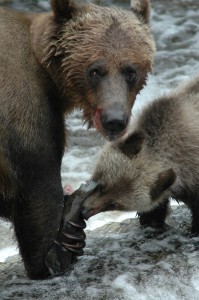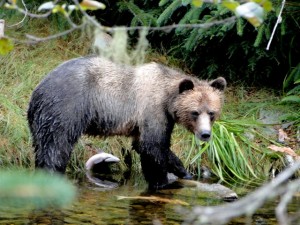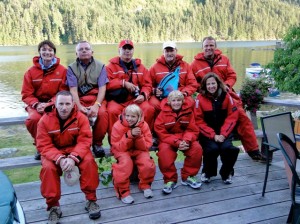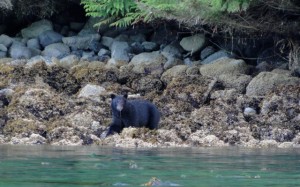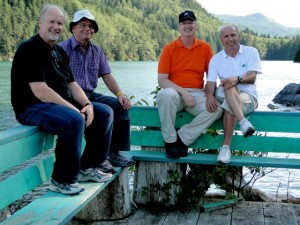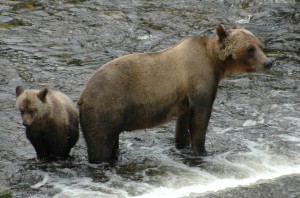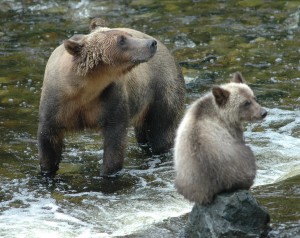All posts by Lodge Guide
The Four Austrians 6 of 11
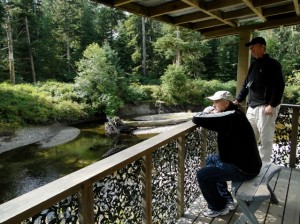
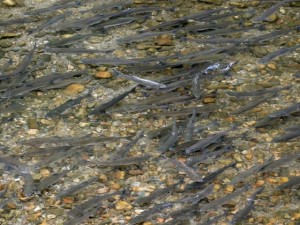 Once the grizzly bear tour arrives in the Glendale River estuary we to transfer to shore and drive a van for fifteen minutes up an old logging road to the two viewing stands on a man-made spawning channel. The stand we normally use has view of the natural river on one side (the view shown) and the entrance to the spawning channel on the other. The stands are large enough to move about for good photos and steady enough to use tripods while others move around. The bears move up and down the river to feed on the pink salmon waiting to enter the spawning area or already in the spawning beds. The pink salmon show are often so abundant that you can not see the river bottom but this still makes it difficult for some bears to be successful at fishing.
Once the grizzly bear tour arrives in the Glendale River estuary we to transfer to shore and drive a van for fifteen minutes up an old logging road to the two viewing stands on a man-made spawning channel. The stand we normally use has view of the natural river on one side (the view shown) and the entrance to the spawning channel on the other. The stands are large enough to move about for good photos and steady enough to use tripods while others move around. The bears move up and down the river to feed on the pink salmon waiting to enter the spawning area or already in the spawning beds. The pink salmon show are often so abundant that you can not see the river bottom but this still makes it difficult for some bears to be successful at fishing.
The Four Austrians 5 of 11
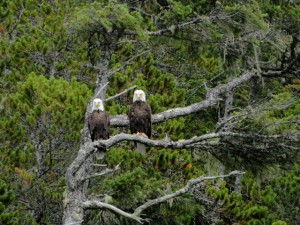
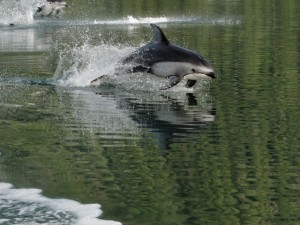 Grizzly Bear Lodge’s day tour to view grizzly bears try to leave camp prior to 8:00 to arrive in Glendale Cove and make it to the viewing stands by 10:00. The viewing stands are used after August 24. The trip up Knight Inlet is always interesting and leaving early gives on more time to enjoy wildlife along the way. First, eagles are a constant interest and there are daily opportunities to some great photo in this case a rare shot of two mates sharing the same branch. For me this is ideal as it allows me to answer an often ask question “Is that a female or male eagle?” Answer “The female is larger and unless they are side by side it is hard to tell the size.” This photo solves that question for these two eagles. Second, pacific white-side dolphins are a constant joy and if I had my choice I could run with them all day. This was a perfect morning for the perfect picture. A glassy calm day on the water which reduces the boats rocking and also permits one to see under the water and know when a dolphin is about to break the surface. All that said an excellent picture such as this still requires many tries and a certain amount of luck.
Grizzly Bear Lodge’s day tour to view grizzly bears try to leave camp prior to 8:00 to arrive in Glendale Cove and make it to the viewing stands by 10:00. The viewing stands are used after August 24. The trip up Knight Inlet is always interesting and leaving early gives on more time to enjoy wildlife along the way. First, eagles are a constant interest and there are daily opportunities to some great photo in this case a rare shot of two mates sharing the same branch. For me this is ideal as it allows me to answer an often ask question “Is that a female or male eagle?” Answer “The female is larger and unless they are side by side it is hard to tell the size.” This photo solves that question for these two eagles. Second, pacific white-side dolphins are a constant joy and if I had my choice I could run with them all day. This was a perfect morning for the perfect picture. A glassy calm day on the water which reduces the boats rocking and also permits one to see under the water and know when a dolphin is about to break the surface. All that said an excellent picture such as this still requires many tries and a certain amount of luck.
The Four Austrians 4 of 11
The lodge normally accommodates eight guests. This means that you interact with the other guests and the staff on a full time basis unless you prefer the privacy of your room. The mornings on the water are be cool so we provide the “floater suites” to keep you warm. They are your “Personal Floatation Device” and even if you choose not to wear them they need to be with you in the boat. After snack time the guides will bring out the suited to make sure you have one that fits this taken care of it is time for your first “quest” for wildlife. The first evening we do a tour looking for black bear and eagles in the vicinity of the lodge, normally an hour or so before or after dinner depending on the tide. The black bears are on the beach looking for food so we need a reasonably low tide to provide the beach. If we don’t have success on the first evening most days we find black bears while on a grizzly or whale tour. This evening was successful.
The Four Austrians 3 of 11
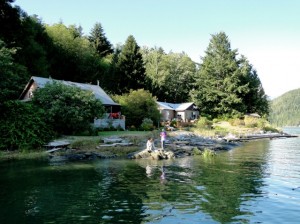
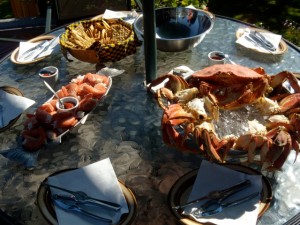 On your arrival your first view of the lodge is from the dock. Guests are shown their rooms and then return to the front deck for a “arrival snack” of cheese, crackers, and fresh caught dungeness crab or prawns (in this case both). This is to get up your appetite for dinner in about two of three hours. Once you have had time to eat or while we have a captive audience all in one place someone will explain about the night lights as we are on a generator, showers, hottub, daily schedule (very flexible) and answer any questions.
On your arrival your first view of the lodge is from the dock. Guests are shown their rooms and then return to the front deck for a “arrival snack” of cheese, crackers, and fresh caught dungeness crab or prawns (in this case both). This is to get up your appetite for dinner in about two of three hours. Once you have had time to eat or while we have a captive audience all in one place someone will explain about the night lights as we are on a generator, showers, hottub, daily schedule (very flexible) and answer any questions.
The Four Austrians 2 of 11
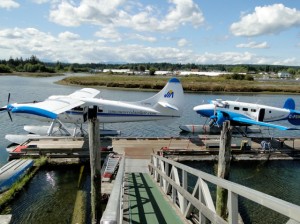
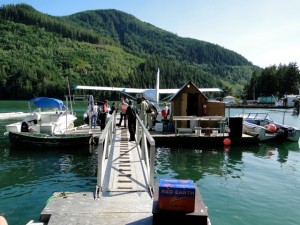 The first photo is a view of the departure dock in Campbell River. Guests leave Campbell River on Vancouver Island once they all arrive and their luggage (any extra room on the plane is filled with food for the lodge) is loaded. Departure by 3:00 or earlier is possible. The flight to the lodge is approximately forty-five minutes and be sure you have your camera ready, as there are some great photo opportunities over the coastal inlets and mountains. Once you arrive there is about thirty minutes of controlled chaos. Often there are eight guest coming and eight guests departing. The arriving guests want to hear for the departing guests how their trip was to gage their chance of success and normally the departing guests want to stretch their stay as long as possible so are glad to talk. Within all this we need to exchange luggage on the plane, incoming for out going, as well as unload any food we managed to get on board. The high tide provides a level ramp and makes us all happy when we carry luggage and food boxes to the lodge.
The first photo is a view of the departure dock in Campbell River. Guests leave Campbell River on Vancouver Island once they all arrive and their luggage (any extra room on the plane is filled with food for the lodge) is loaded. Departure by 3:00 or earlier is possible. The flight to the lodge is approximately forty-five minutes and be sure you have your camera ready, as there are some great photo opportunities over the coastal inlets and mountains. Once you arrive there is about thirty minutes of controlled chaos. Often there are eight guest coming and eight guests departing. The arriving guests want to hear for the departing guests how their trip was to gage their chance of success and normally the departing guests want to stretch their stay as long as possible so are glad to talk. Within all this we need to exchange luggage on the plane, incoming for out going, as well as unload any food we managed to get on board. The high tide provides a level ramp and makes us all happy when we carry luggage and food boxes to the lodge.
The Four Austrians 1 of 11
This is the story of four great guys, “the team consisting of the 4 Austrians Ingo, Sigurd, Walter and Heinz”. They say it best in their own words: “Please find below as required some fotos from our stay in your lodge in August this year. It gave us great moments and unique memories of a fantastic fauna in overwhelming nature.I hope you can use it in your website and show it to guests who are interested what their stay in the lodge would be all about. We appreciated very much the whole setup, means the lodge, the trips, the food and all the care you and your team provided for us.All in all it was a very successful choice to book your program and we can only highly recommend it to all who love to explore nature and stay in a lodge which is very small (only 8 guests at a time) and allows therefore very personal but professional care.Thanks again for everything and best regards to everybody there.The team consisting of the 4 Austrians Ingo, Sigurd, Walter and Heinz”
Northern Resident Orca Identification
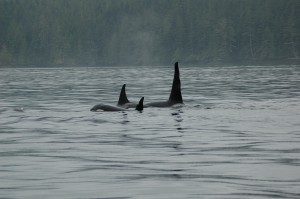
If you have the time to open another browser click here
Killer Whales of the Northern Resident Community
northenresidentorcas.blogspot.com// you will be in a website which identifies all the orca that we observe each summer. The map area in red shows the area frequented by the northern resident orca and this is basically the area we cover when we go on our whale-watching safari. If you click on “A1 pod – A30 matriline” and scroll down until you come to “A72 Bend” if you look closely you will discover that this one of the orca in the photo. Some great video of the orca the orca is provided the second one has sound.
Cubs waiting to for salmon
The mother grizzly bears on the Glendale River bring their cubs with them when they come to fish. These first year cubs born in January or February are waiting patiently for a meal to be provided. One is lucky in that it has a dry rock to sit on while the other looks less sure balanced on a wet and likely slippery rock. It is not uncommon to have an age mixture in the grizzly bears we view from the stands in the fall. A mixture from first year cubs with mothers, sub-adult bears as well as fulls adults. The abundance of salmon to eat and the short time to fatten for the winter does not allow time for much fighting.
Grizzly Bear Claws
